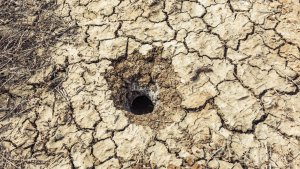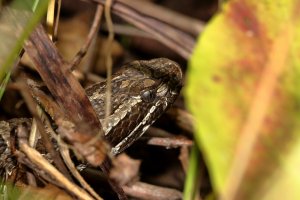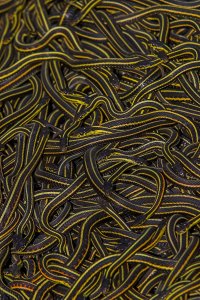Snakes in the Snow
January 24, 2024
By Alexis Olechowski
Michigan undergoes a captivating transformation into a winter wonderland as snow blankets its landscapes, and temperatures plummet to frigid levels. While some might associate this season with hibernation and stillness, the state’s wildlife is far from mundane. Some of our favorite animals vanish into the lesser-known corners, during the winter. A secret world of survival and adaptation, where snakes defy the chill, and the intricate web of life persists. It’s a celebration of nature’s ability to not just endure but to thrive, reminding us of the beauty that emerges when we take a closer look at our favorite winter wonderland. So where do all the snakes go during winter? Embark on a journey to unravel the mysteries of Michigan’s unique snakes and their adaptations to survive in the snow.
While many creatures seek refuge from Michigan’s winter chill, snakes, often misunderstood and underappreciated, showcase captivating adaptations that allow them to thrive in the cold. As ectothermic beings, snakes depend on external heat sources to regulate their body temperature. Yet, Michigan’s diverse snake species have evolved ingenious tactics to overcome winter challenges around hibernation, or in the reptile world, brumation. Brumation is a more correct way of describing the winter dormancy of reptiles and most amphibians in Michigan and differs slightly from hibernation in mammals. From about October – April, snakes in Michigan will stay dormant either underground, in a burrow previously dug by another animal, or tucked in a rock crevice or cave. Embracing brumation and utilizing microenvironments, these serpentine residents gracefully navigate the frigid months with remarkable resilience.

The Eastern Massasauga Rattlesnake, Michigan’s only venomous snake, faces winter by entering a state of brumation. Unlike hibernation, which involves a deep, prolonged sleep, brumation is a slowed-down state where the snake remains somewhat active. The Eastern Massasauga Rattlesnake may brumate for up to 6 months over the winter using a hibernaculum, or underground cavity, often an abandoned crayfish tunnel or rodent burrow. Hibernaculum must be at least a foot below ground where the snake is partially submerged in water, to prevent freezing and to allow them to “breathe” through their skin. By descending below the frost line, they escape the most extreme temperatures and conserve energy until spring prompts them to

emerge in search of prey. Unlike many other snakes, they brumate alone or in small groups of 2-7 animals. They will usually return to the same site to brumate every year. In spring, after emerging from their hibernaculum, they spend a great deal of time basking in the sun. This helps warm their bodies and gets their metabolism going again. They will spend most of the spring basking before moving to their summer habitats to feed and find mates.
Eastern garter snakes, common throughout Michigan, employ a slightly different strategy to survive winter. Instead of brumating alone in wet tunnels like the Eastern Massasauga Rattlesnake, they gather in large groups within one hibernaculum. These communal dens are often occupied by hundreds or even thousands of garter snakes at one time, located in natural cavities or human-made structures like abandoned buildings. While they can’t produce their own body heat by sharing the warmth generated by their collective heat, garter snakes can maintain a more stable internal temperature, ensuring their survival throughout the winter months until emerging in masses in the spring.

While each snake’s brumation strategy may vary by species, all Michigan snakes have found unique ways to endure the cold months. As spring arrives, when the days are longer and the temperature is consistently warm, Michigan’s snakes emerge from their winter resting spots. They will spend the spring and summer months mating and finding food before returning to their hibernaculum in the fall. Despite being misunderstood and feared, these fascinating members of Michigan’s wildlife community play a crucial role in wetland habitat function, acting as both predator and prey. Snakes are vital to ecosystems, even if they aren’t your favorite animal. They keep vole and other small pest populations in check, and they provide food for many other animals, such as herons, foxes and owls. The Eastern Massasauga Rattlesnake is considered a keystone species by the U.S Fish and Wildlife Service because the presence of a small number of these rattlesnakes has a significant impact on the rest of the food chain. Their presence, if respected, contributes to the delicate balance of ecosystems, highlighting the importance of coexistence with these captivating creatures.
Gaining insights into the habitats and survival needs of these species is essential for devising effective conservation strategies. Unfortunately, snake populations are experiencing a gradual decline, primarily attributable to the loss of crucial habitats such as wetlands and grassy areas. The encroachment of human activities, including traffic and mowing, has exacerbated this decline, leading to unintended fatalities for these reptiles. Recovery actions for the Eastern Massasauga Rattlesnake focus on reducing threats to existing populations by addressing habitat loss, along with impacts from flooding and drought, disease, and intentional killing. Recognizing the threats posed by habitat loss and human activities, it becomes imperative for us to take proactive measures in safeguarding these fascinating creatures. So how can you help? Don’t remove Michigan snakes, leave them be! Simply leaving snakes alone and using care when walking in natural areas will prevent nearly all bites – these creatures do not seek confrontation with humans and accidental bites are rare. By understanding their habitats and promoting coexistence, we can contribute to the preservation of Michigan’s diverse snake populations and foster a harmonious balance between the natural world and human activities.
